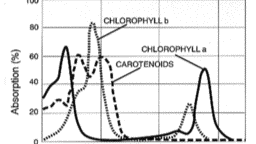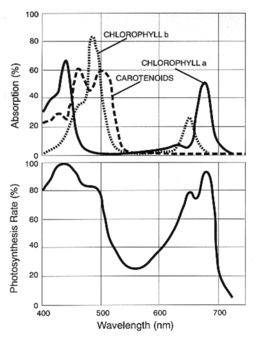Light Quality and Quantity


Light is important as plants use part of the radiant energy emitted by the sun for photosynthesis. Light is usually confused with energy. Light quality is the wavelength (in nanometers, nm) within the electromagnetic spectrum; i.e. blue light is 450 nm and red light is 650 nm. Each wavelength has a different packet of radiation or energy (in J mol-1) called photons. The energy of a photon is inversely proportional to its wavelength; the shorter the wavelength, the higher the energy and the longer the wavelength, the lower the energy, i.e. the energy of short wave, blue light is 2.66x105 J•mol-1 and longer wave red light is 1.81 x105 J•mol-1. Light levels directly affect transpiration, water uptake, flowering, germination, intermodal growth, etc. within the plant.
What is Solar Radiation?
It is the radiant energy emitted by the sun with wavelengths between 280 to 2,800 nm. It can be subdivided into ultraviolet (100-380 nm), visible light (380-780 nm) and infrared (700-3000 nm). Ultraviolet radiation (especially UV-B and UV-C) can be harmful to plants because it can produce photochemical damage to cellular DNA and decrease photosynthetic rate. Near-infrared radiation (700-1500 nm) causes the leaf temperature to rise. Most of the visible light band is used for photosynthesis. Solar radiation is measured with a pyranometer and it is expressed in W•m-2; during a sunny day, the solar radiation can reach up to 1000 W•m-2 (instantaneous measurement). In greenhouse agriculture, solar radiation can be used to schedule irrigation since this energy triggers plant transpiration. Plants use up to 5% of the solar radiation for photosynthesis, the rest is used for evaporation. Solar radiation is affected by season, latitude, elevation, environmental conditions and time of the day.
What is visible light?
Visible light consists of wavelengths between 380-770 nm and is divided into: violet (380-430 nm), blue (430-500 nm), green (500-570 nm), yellow (570-590 nm), orange (590-630 nm) and red (630-770). Humans can perceive this light with the naked eye as color. It is measured with a photometric sensor and it is expressed in foot-candles or lux. The ornamental horticulture industry uses this parameter to determine the light needed by plants for growth and development. The problems with this type of measurement are that it is an instantaneous measurement and plants do not use the green waveband.
What is Photosynthetic Active Radiation (PAR)?
PAR is the amount of light energy within the 400-700 nm wavelength range used by plants for photosynthesis. Photosynthesis is the transformation of CO2 + water with the presence of light into sugars and oxygen. Chlorophyll, the green pigment in leaves, is responsible for absorbing the PAR energy. PAR is measured with a quantum sensor and it is expressed in μmol•m-2•s-1. Readings range from 0 (at night) up to 3000 μmol•m-2•s-1, but on a clear, sunny day, PAR emitted from the sun could be 2,000 μmol•m-2•s-1 (instantaneous measurement). PAR is useful to determine plant growth and development when the quantity received each day as a function of light intensity (instantaneous measurement) and duration (per day) is added up. Based on accumulated PAR, it is possible to compare growth and development patterns between different plants in different greenhouses. For example, tomato plants need to accumulate approximately 1000 moles•m-2 of PAR to flower whether they are in the North Pole or the equator. More light means more photosynthesis and plant growth, but excessive light in terms of quantity and quality does not mean that the plant will grow more since there is a saturation point. It is possible to convent PAR to foot-candle or Lux and vice versa only if those measurements are within the PAR range and during a clear day.

Finally, it is extremely important to know which part of the electromagnetic spectrum (waveband - quality) is going to be measured, how much energy is emitted (photons or quanta - quantity) and what is the effect on plants. By knowing this, it is possible to optimize plant growth and development in terms of money and time.